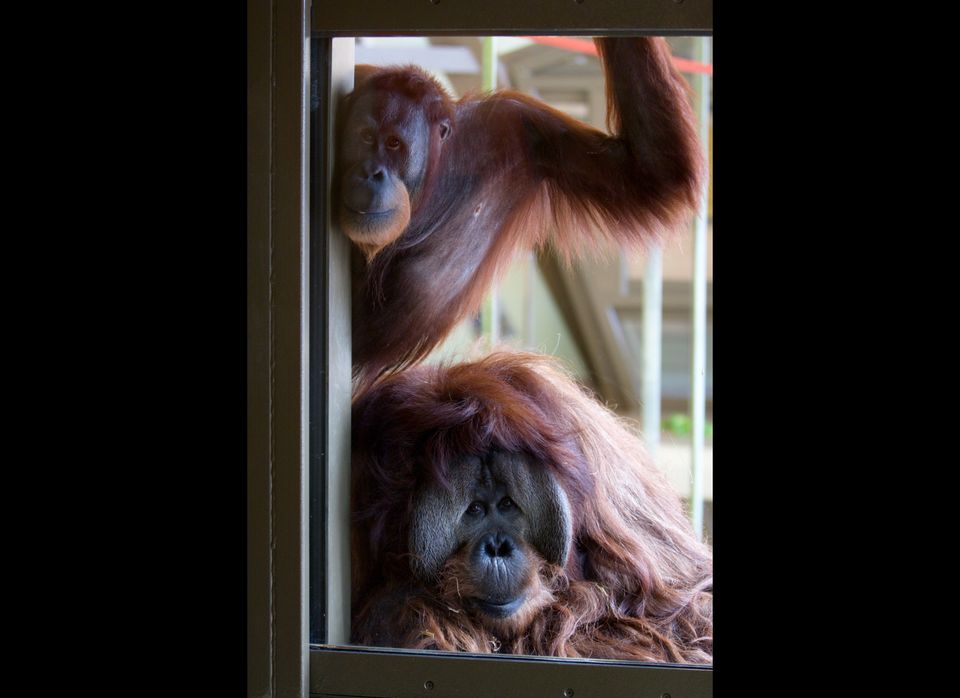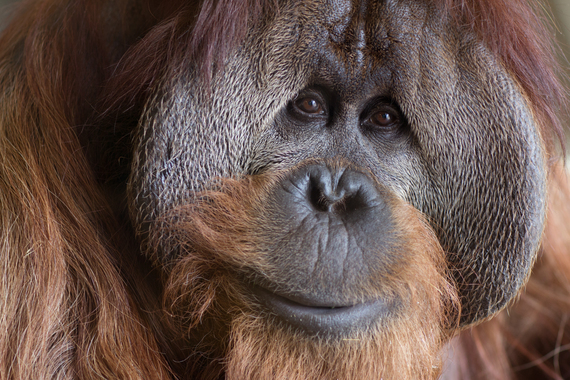After six decades of Zoo visits on five continents, and a number of safari treks through animal habitats in Southern and Western Africa, I frankly thought I had seen it all. However, a few weeks ago I realized that there were members of one of the great ape families in a zoo very near my home that I hadn't become acquainted with - orangutans, to be exact. These colorful apes have surprising talents and abilities that were very impressive and new to me. I was sad to also learn that they are among the most endangered species on earth.
I observed these stunning black eyed orange/red haired, long armed creatures living in a 21st century architectural wonder enclosure that allowed us homo sapiens to view them as they scampered through a multi story, 40 to 80 feet high glass, steel cabled, and concrete village skyscraper - with no trees in sight. I refer to the Indianapolis Zoo's $26 million dollar Simon Skjodt International Orangutan Center that opened in May 2014, a part of the 64 acre zoo site near downtown Indianapolis in White River State Park.
The exhibit houses eight orangutans of assorted sizes, ages and temperaments who scamper up, down and around an environment that allows them to congregate in small groups or find space for solitary reflection. The reviews on this groundbreaking avant-garde architecture have been mixed. Some visitors find it an alarming multi- story space voyager contraption, with no resemblance to orangutan environments in their native Asian habitats.
Other visitors, including me, were struck by the ease and flexibility of the very nimble mammals to scout out their enclosed and open-air environment and make eye contact with their genetic cousins on the other side of the glass. After a little over one year of occupancy, they have adapted well to their new habitat. I should note that these Indianapolis Zoo residents have always lived in captivity and therefore can't miss something they don't know. All of them had arrived from other Zoos.
The most surprising and enlightening experience of my encounter was with the very well known Azy who demonstrated his cognitive skills with his teacher, Dr. Rob Shumaker, during a computer showcase. Dr. Rob, orangutan expert, evolutionary biologist, and researcher presents his exercises with Azy to daily visitors to the Zoo. The professor noted that he works with his pupils individually. He doesn't want to encourage competition or jealousy among his small Congress, the official name of a group of orangutans.
The Star Azy (and a long time research subject) was already in the studio when the audience was seated. Behind the studio glass enclosure, he looked completely non-plussed on his platform perch in front of a large touch screen computer. He glanced at the audience and his instructor, while waiting to begin his tasks, looking alert and ready.
The entire demonstration lasted about 20 minutes. Dr. Bob led Azy through a series of computer prompts requiring him to respond to graphic and numerical symbols using mathematical calculations and identifying relationships between symbols. After Azy completed each of the series of computer commands by touching his computer screen, he was rewarded with a treat that he either devoured immediately, or set aside for the moment.
By my calculation, Azy was correct on the majority of his responses. The quiet but attentive interplay between the two reminded me of a confident and well schooled interaction between two humans with a meaningful history. This session confirmed for me: Orangutans are smart! It was a real treat to be seated very close to Dr. Bob and Azy. You won't find this kind of encounter at any other Zoo in the world.
Factoids on Orangutan
•Orangutans are the largest arboreal animals on the planet.
•Approximately 35,000 to 50,000 live in either Borneo or Sumatra.
•10 percent of their populations die because of loss of habitat each year.
•Orangutans can live to 60 years in the wild or in captivity.







